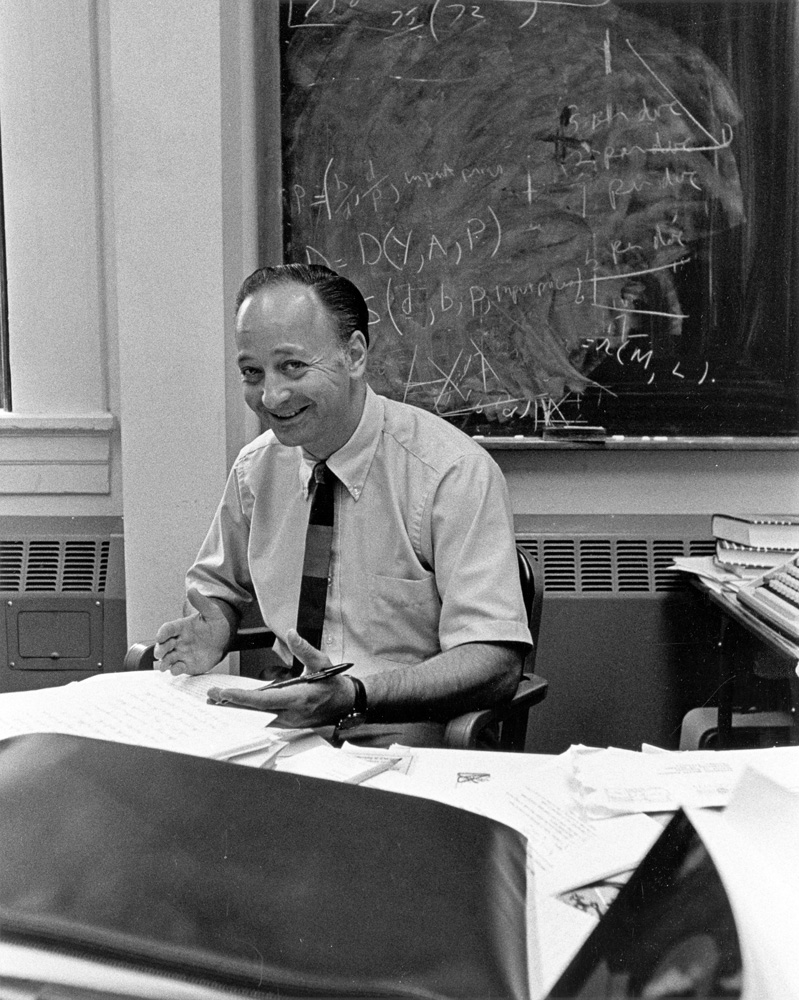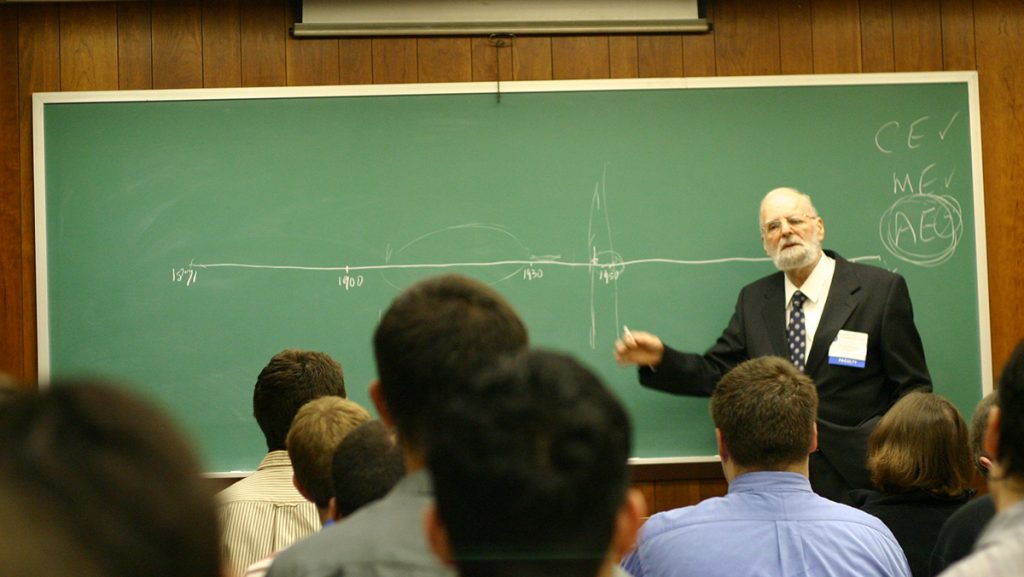Economists Harold Demsetz and Israel Kirzner challenged the prevailing orthodoxy in microeconomic analysis and public policy beginning with their respective work in the 1960s. They developed a dynamic understanding of market competition, putting emphasis on conditions of competitive entry and exit rather than on market structure.
Editor’s note: The current debate in economics seems to lack a historical perspective. To try to address this deficiency, we decided to launch a Sunday column on ProMarket focusing on the historical dimension of economic ideas. You can read all of the pieces in the series here.
The Chicago School of Economics is well-known for being a bulwark in defense of unregulated laissez-faire capitalism. However, even George Stigler, one of the key figures of the Chicago School and author of the seminal paper “The Theory of Economic Regulation,” had once been a proponent of government regulation against monopoly power.
“Economists (including me),” Stigler states in his intellectual autobiography Memoirs of an Unregulated Economist, “generally believed that…industrial concentration allowed a substantial amount of noncompetitive behavior.” He therefore “believed that monopoly posed a major problem in public policy in the United States, and that it should be dealt with boldly by breaking up dominant firms and severely punishing businesses that engaged in collusion.” By the 1960s, however, Stigler had become persuaded otherwise due to a paradigmatic shift that began to unfold in the economic analysis of competition and its public policy implications for monopoly regulation. Who and what contributed to this change?
Harold Demsetz, who Stigler credits directly, as well as Israel Kirzner, challenged the prevailing orthodoxy in microeconomic analysis and public policy, beginning with their respective work in the 1960s. They each developed a dynamic understanding of market competition, putting emphasis on conditions of competitive entry and exit rather than on market structure. In addition, they drew attention to the creative adaptations and adjustments that economic actors engage in throughout a competitive economy, the multiple margins of adjustment that individuals, as buyers and sellers, engage in through the market, and how alternative institutional arrangements impact competitive behavior. In Economic, Legal, and Political Dimensions of Competition, Demsetz states, that “[m]arket processes work neither instantaneously nor with full knowledge, so perfect competition hardly exhausts the many ways in which self-interest is pursued. Competing through product quality, contractual arrangements, and institutional innovation, and through tactical quickness and alertness, all become meaningful.” In the work of Demsetz and Kirzner, this emphasis on adjustment and adaptation to changing circumstances results in a rediscovery of the role of the entrepreneur in a vibrant and growing economic system.

The aspect of Demsetz’s and Kirzner’s respective contributions that we want to emphasize is their work on the rivalrous nature of competitive behavior and the market process. They address fundamental questions in the analysis of market theory and the operation of the price system, which is at the very foundation of economic science. They explore economic behavior in its given variety and complexity, and the institutional environment that enables entrepreneurs in a market economy to realize the mutual gains from trade, to continuously discover the gains from innovation, and to result in the system being characterized by economic growth and wealth creation.
For these contributions, Demsetz and Kirzner were each recognized for their fundamental contributions to the field. Demsetz was named the Distinguished Fellow of the American Economic Association in 2013, and Kirzner in 2006 received the Global Award for Entrepreneurship Research. However, we believe both their works should be read and appreciated more by modern students of economics, in particular those working on issues of industrial organization and antitrust policy.
Since its inception, economic science has consisted of two claims that theory sought to reconcile—the self-interest postulate and the invisible hand proposition. With the development of modern formal equilibrium theory, many explained the relationship between these two by collapsing the one to the other through stringent cognitive assumptions and postulating a frictionless environment, or sought to demonstrate the inability to square these two claims due to cognitive shortcomings or a variety of frictions postulated. Thus, the various debates in political economy about the role of government in the economy tend to turn on a postulate of perfect markets or a demonstration of deviations from that ideal due to imperfect markets.
From the beginning of their careers, Demsetz and Kirzner pursued a different intellectual path while tackling issues associated with monopoly power, externalities, and a variety of deviations from the textbook ideal of perfect competition. Neither of them reasserted the perfect market ideal. Instead, they demonstrated that deviations from the textbook notion of the ideal does not necessarily prevent the price system from coordinating economic activity, but in fact depended on it, since such deviations from the ideal represented entrepreneurial profit opportunities, which fuels the tendency towards equilibrium. Moreover, this coordinative tendency in the market process is predicated upon a certain set of institutional conditions, based upon private property and freedom of contract under the rule of law.

In making their respective arguments about the nature of market competition, each turned to the rivalrous behavior of entrepreneurs in the marketplace. Entrepreneurship is seen as the key to the stimulation of economic growth, and alternative institutional arrangements impact the direction of entrepreneurial attention. The entire research areas on the manipulation and strategic use of the rules of the game by economic actors can be traced back to this central role of the entrepreneur in commercial society. Governance matters and context matters, both theoretically as well as empirically. The pattern of entrepreneurial activity in any society toward wealth creation, or toward unproductive “rent seeking” and “superfluous discovery” is a function of the rules of the game. Yet, in standard economic theory, the entrepreneur remains an elusive character. But, unless we put this character front and center in our analysis, we are stuck as economic analysts of the operation of the market economy and the dynamics of economic growth in a position analogous to a theatre critic discussing Hamlet without recognizing who is the Prince.
This is particularly relevant at the present moment, when many within the economics profession and the public policy community are stressing the potential monopoly problems associated with the “platform economy.” Traditional definitions of industrial structure underestimated the role of competitive forces and entrepreneurial innovation by focusing on concentration and firm size rather than the conditions of entry and exit in any market. As the work of Demsetz and Kirzner has illustrated (and also William Baumol on the theory of contestable markets), even large firms currently in possession of a significant market share will behave as if they were in a competitive market when a market is contestable.
“From the beginning of their careers, Demsetz and Kirzner pursued a different intellectual path while tackling issues associated with monopoly power, externalities, and a variety of deviations from the textbook ideal of perfect competition.”
Even if contestability is present, neither Demsetz nor Baumol would deny the potential for monopoly power or other market imperfections. But the fundamental theoretical insight Kirzner (and Demsetz) developed concerning how the market works is predicated on the price system being an error detecting and corrective learning process in the face of such market imperfections. “If a market is not in equilibrium,” as Kirzner states in Market Theory and the Price System, “this must be the result of ignorance by market participants of relevant market information. The market process, as always, performs its functions by impressing upon those making decisions those essential items of knowledge that are sufficient to guide them to make decisions as if they possessed the complete knowledge of the underlying facts.” Thus, while it may be the case that only one firm may be producing in a particular market, this does not necessarily imply, as Demsetz and Kirzner highlight, the absence of rivalrous competition among entrepreneurs for ownership of such a firm.
The market process, according to Kirzner, can be understood in terms of two sets of variables. There are underlying variables, which included tastes, technology, and resource availability. The induced variables include prices, profit and loss signals, and the pattern of resource ownership. The market process can be described as the continuous activity that results from buyers and sellers trying to satisfying their plans for betterment, creating a tendency towards which the underlying and induced variables dovetail. When the production plans of some perfectly dovetail with the consumption plans of others, the induced and underlying variables are consistent with one another, under which the conditions of equilibrium hold. If no mutual consistency exists between the underlying and induced variables, then economic activity continues because it will be in the interest of the parties to continue to seek a better situation than they are currently realizing.
Demsetz’s contribution was less abstract than Kirzner’s, and more applied in terms of deriving the implications of viewing competition not as an end-state, but as an ongoing set of rivalrous activities, which entail multiple margins on which creative economic actors can adjust and adapt. Starting with his work in the late 1950s, Demsetz began challenging the then prevailing orthodoxy concerning monopolistic power, natural monopoly, and industrial structure. He famously argued in “Why Regulate Utilities?” that “we have no theory that allows us to deduce from the observable degree of concentration in a particular market whether or not price and output are competitive.” Provided that there is vibrant competition for the field among potential providers of a service, Demsetz reasoned, there would be no reason for regulation due to a threat of monopoly power. Even if industrial concentration exists due to economies of scale, “there is no clear or necessary reason for production scale economies to decrease the number of bidders,” Demsetz argues. Demsetz drew an important distinction between competition within a market or “field,” and competition for the field, such that concentration in the former does not necessarily imply the latter.
Demsetz would later develop this point and show that even in the presence of short-run monopoly power, the rivalrous behavior of individuals and firms in the market would erode this power. As he states in “Industry Structure, Market Rivalry, and Public Policy,” there is “no reason to suppose that competitive behavior never yields monopoly power, although in many cases such power may be exercised not by creating entry barriers, but through the natural frictions and ignorance that characterize any real economy. If rivals seek better ways to satisfy buyers or to produce a product, and if one or a few succeed in such endeavors, then the reward for their entrepreneurial efforts is likely to be some (short term) monopoly power and this may be associated with increased industrial concentration. To destroy such power when it arises may very well remove the incentive for progress.” Demsetz would also argue in a seminal paper with Armen Alchian, “Production, Information Costs, and Economic Organization” that “[c]onceiving competition as the revelation and exchange of knowledge or information about qualities, potential uses of different inputs in different potential applications indicates that the firm is a device for enhancing competition among sets of input resources as well as a device for more efficiently rewarding the inputs.”
The work of Demsetz and Kirzner is as critical to understanding the dynamics of marketplace today as it was when they first approached their studies of industry structure and competitive behavior. And, as recognized by classic economists such as Frank Knight and Joseph Schumpeter, the central actor in managing this process of changing circumstances and adaptation to new opportunities is the entrepreneur. The entrepreneur’s central function is to act on hitherto unrecognized opportunities for mutual gain, whether those come in the form of arbitrage opportunities or technological innovations which cut costs in production and distribution or the discovery of new products that meet consumer demand. It is entrepreneurial action that sets in motion the competitive market process and which results in the adaptations and adjustments to changing conditions such that complex coordination of economic plans is achieved, wealth is created, and economic progress is perpetuated.
For these reasons, and more, we believe that Demsetz and Kirzner have done more than other economists of the modern era to improve our understanding of competitive and rivalrous behavior of individuals, and the operation of the price system in a market economy. Throughout their respective careers, Demsetz and Kirzner have provided fundamental challenges to the prevailing orthodoxy of textbook perfect competition, the structure-conduct-performance paradigm in industrial organization, and its implications not only for theory, but policy as well. Their dynamic understanding of competition as an active process of rivalry implies that public policy should not be directed at correcting market failures per se. Rather, it should not set up the market for failure by stifling the conditions and multiple margins of competitive entry.






